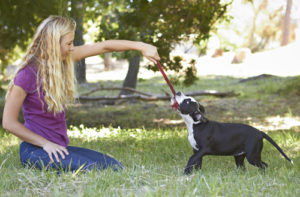Of all the doggy myths, urban legends, and wives’ tales I have heard throughout my life, I think this is the one that still gets the most debate. I hear people saying, “Don’t teach your pit bull to tug, he’ll attack you.” Or “if you let your dog win at tug, he will think he is more dominant than you.” Then again, my dog trainer friends who do agility use it as a foundation for their training, teaching their eight week old pups who to tug before they know how to sit.
In my own life, I have wondered if tug was not somewhat responsible, or at least not helping, my sheltie learn self-control and inhibition while working livestock.
So what’s the answer?
I decided to interview Robin Bennett CPDT-KA, celebrated dog trainer and author of several books to see what her take is on tugging.
Are there dogs that should not play tug? Why?
Generally speaking I think tug is fine, but I do require some ground rules when playing. I would not play tug if the ground rules are not used, particularly with a dog that is already having biting or impulse control issues (which usually show up as biting problems!)
The ground rules I use would include:
- Teaching the dog to drop
- Teaching a dog that the game ends if he comes up the tug toy to your hand.
I think for many dogs, even without rules, you can play tug and nothing serious will happen. But there are a few dogs who are more prone to poor behavior or have trouble inhibiting their bite, or have issues with impulse control and getting them revved up without an “off” switch will only add to their problems. I don’t want to make a possible problem area worse, which is why I like to use the game as a way to help teach impulse control.
Will it really increase the likelihood of biting? It is true that in protection work, you can increase a dog’s bite by doing tug. So I do think you can teach a stronger bite on an object by playing tug. I do not believe that playing tug translates to biting people though. So this is a “yes and no” response. I think if you want to get a stronger bite or hold on a tug toy, a protection sleeve or a rope, then playing tug can help, but I don’t think that will mean a dog is going to be more prone to biting outside the context of play.

Is there an appropriate way to tug?
This goes back to the ground rules. I teach “drop it” (I actually use the word leave it though) as soon as I begin playing tug and I want the dog to eventually learn to drop an object on command knowing that he gets the toy right back. This allows me to have some control over the game. I also stop the game if the dog bites my hand, redirects to my hand (or other body part for that matter) or if he bites up the rope to my hand. I consider these all “fouls” that end the game immediately. And by ending the game, i mean I take the toy away and go sit down. Game over….for at least 3-5 minutes, often longer. When I have worked with dogs, the joy of the game is usually enough to keep them playing within the boundaries established.
If your dog has already been tugging, will it make a difference if you stop?
If you are having impulse control issues, then stopping the game will just eliminate one area where impulse control might be a problem. But just stopping that type of play won’t solve the overall problem the dog might have.
What would be a better alternative game to tugging?
If I had a dog that got too revved up and couldn’t play by the rules and for whom tug created more problems, then I would recommend some other high energy activity such as fetch. I might also recommend a high energy sport such as running, scooting, agility, etc. However, for me, a dog who does have an issue with tugging is usually a dog that needs overall work in impulse control and also needs a good way to burn off energy and mental stimulation.
Myth Busted? Well, sort of.
In general, it seems that tug is a perfectly fine way to bond and get your dog some exercise, as long as she follows the ground rules. If your dog is biting you, then most likely, as Bennett explains, he has a self-control problem that is not going to be solved simply by not playing tug.
About the Author
Based in Tustin, Calif., animal lover Kristina N. Lotz is a Certified Professional Dog Trainer – Knowledge Assessed (CPDT-KA) and works as a full time trainer. She also owns her own custom pet products company, A Fairytail House, where she makes personalized collars, leashes, beds, keepsake pillows and blankets, and anything else your imagine can think up. In her spare time, she trains and competes in herding, agility, obedience, rally, and conformation with her Shetland Sheepdogs. She smartly married a Veterinary Technician, who helps keep the fur kids happy and healthy, and provides a quick resource for articles.
